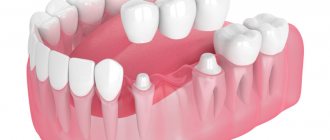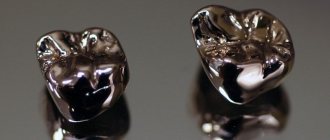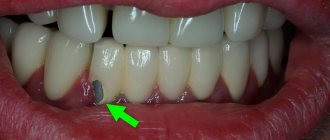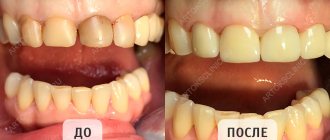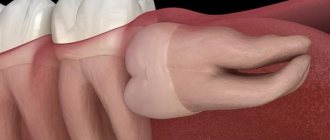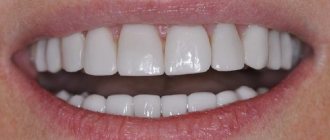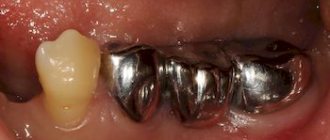A crown is a permanent prosthetic structure that is used to replace the visible part of a missing or damaged tooth. The service life of the product depends on various factors. First of all, this is the quality of the design, accuracy of installation, material and localization in the oral cavity. With proper care and respect, dentures can last more than 10 years. Replacement of the structure is required if there is bad breath, discomfort, looseness or damage. In this case, the patient is recommended to consult a dentist.
Is it possible to remove the crown?
Almost every patient who has undergone orthopedic treatment wonders whether it is possible to remove the crown from a tooth. Installing a crown is a non-removable type of prosthetics, but this does not mean that they cannot be removed in principle. In dentistry, removable dentures are those structures that can be pulled out of the mouth independently. In turn, fixed dentures are removed in the dentist's office using special equipment and tools. Another popular question: which doctor removes crowns from teeth? This should be done by an orthopedic dentist, but in some clinics the therapist also removes crowns, which, of course, is not entirely correct.
Method No. 1: sawing with a boron
So, let's figure out whether it is possible to remove a crown with permanent cement.
The method of removal using boron is the oldest and by far the most unaesthetic. This means that after using this tool, the sawn artificial material will only have to be thrown into the trash bin, because it can no longer be used for its intended purpose, that is, it will no longer be possible to re-prosthetize a tooth with it.
The technique is simple, cheap and quite effective, but it must be used by a doctor who has a high level of professionalism, because the approach requires caution and precision. An inexperienced specialist may damage the tooth itself or the soft tissue around it during the dismantling process.
With this method, it will not be possible to reuse the crown
“We removed the crown from the tooth with a regular bur and simply sawed it in half. There’s nothing terrible, but when the material got very hot, the smell, I’ll tell you, was not very good, plus there were slightly painful and uncomfortable sensations, even despite the fact that I had been given anesthesia before this, and the tooth itself had been under the prosthesis for a long time depulped!"
Mari, review from 32top.ru
This method is used if the patient has dentures made of inexpensive materials, which he would not mind disposing of later. The method is also suitable if the artificial structure itself is mobile or wobbly. Then it is simply sawed to the teeth, then, using special tools, the resulting edges are carefully bent in different directions and removed.
Why is crown removal necessary?
The average lifespan of a standard crown that covers a natural tooth is about seven years. If the crown is installed on an implant, then it may well last for fifteen years. As a rule, the removal of a crown from a tooth is carried out for a number of reasons.
- Errors during prosthetics. Most often, the fault lies with specialists who made a mistake at one of the stages of treatment. Incorrect manufacturing of the product, incorrect calculations at the preparatory stage, the use of low-quality materials - all this leads to the fact that the prosthesis cannot function properly and has to be removed.
- Injuries and mechanical damage, after which further use of the dental crown becomes impossible.
- Diseases developing under the crown. Secondary caries, periodontitis, cysts are complications in which tooth treatment without removing the crown is almost impossible.
- Gum diseases requiring removal of the denture for treatment procedures.
- Expiration date. Each crown has its own lifespan (especially when installed on a natural tooth). If a crown has lost its functional and aesthetic qualities over time, it must be replaced. Often the crown falls out on its own due to damage or destruction of the bonding agent.
- The desire of the patient himself. For example, in order to replace an old metal or metal-ceramic structure with a more modern and aesthetic product.
Dangerous symptoms!
- Constant pain under the crown indicates the development of an inflammatory process and the need for re-treatment.
- Unpleasant odor concentrated in the crown area. It usually occurs due to the decomposition of tissue under the crown or the ingress of food particles, which indicates a violation of the seal.
- The crown becomes mobile. This is due to decay of the tooth or dental cement under the crown.
If you experience the above symptoms in one form or another, we advise you to contact your dentist as soon as possible. After taking an x-ray, it will become clear whether you have a hidden problem and whether the crown needs to be removed.
Zirconium dioxide dental bridges –
Zirconium dioxide ceramic bridges are manufactured using CAD/CAM technology, which involves milling bridges from pressed zirconium dioxide blocks on a computer-controlled machine. Sintered zirconium dioxide has a strength comparable to metal (more than 900 MPa). Thanks to this, zirconium dental bridges can be made of any length - even horseshoe-shaped bridges with a length of 12-14 teeth (which cannot be made from any other types of metal-free ceramics).
We have already said above that a zirconium bridge is the gold standard for prosthetics of the chewing group of teeth. But there are questions about the aesthetics of zirconium dioxide bridges, and when prosthetizing the front teeth, you may encounter a big problem (the bridge will stand out against the background of the patient’s own teeth). The fact is that there are 2 types of bridges and crowns made of zirconium dioxide, and they differ from each other not only in aesthetics, but also in the risk of ceramic chips.
1) “Traditional” zirconia bridges –
For such bridges, only the internal frame will be made of zirconium dioxide, which is lined with ceramic mass, or rather porcelain, on the outside (Fig. 14). And this is due to the fact that most dental laboratories use cheap versions of zirconium dioxide blocks. This zirconium dioxide has a bright white color, plus it is completely opaque, and as a result, such a material does not allow achieving a certain degree of translucency, which is characteristic of natural tooth enamel.
Crowns and bridges made from such material will have an unnatural milky white color, plus there will be no translucency characteristic of natural teeth. Therefore, in order to improve aesthetics, only the internal frame is milled from such zirconium dioxide, which gives strength to the structure, and then the dental technician, by applying layers of porcelain, gives the crowns of the bridge the final shape and color. But even despite this, the aesthetics of such crowns and bridges will be far from perfect.
Plus, this manufacturing method has another disadvantage. We have already said above that zirconium dioxide has the strength of a metal (from 900 MPa), however, the layer of porcelain mass on the surface of the zirconium frame has a strength of only 80-120 MPa. This leads to chips of the ceramic mass (according to statistics, within 6 years they occur in approximately 10% of patients). The chips are repairable, but the reliability of such repairs leaves much to be desired.
Conclusions : we do not recommend using zirconium dioxide bridges (made with a surface layer of porcelain) for prosthetics of chewing teeth, because in this case there will be a high risk of chipping. When replacing front teeth with prosthetics, this option is not very successful, because the crowns of the bridge will still have an unnatural milky tint, standing out against the background of your own teeth (Fig. 15-16). Plus, there is still a risk of chipping the porcelain lining.
The aesthetics of such structures are
Such milky-white crowns and bridges made of zirconium dioxide will look acceptable only in one case - if you are going to simultaneously prosthetize all the teeth that fall into the smile line on both the upper and lower jaws (i.e. at least the fifth teeth inclusive ). Otherwise, such a bridge will be very noticeable against the background of your own teeth.
2) Zirconium bridges using “Multi-layer” technology –
But the problem of poor aesthetics and chipping was solved by the advent of the next generation of zirconium dioxide blocks/discs. Currently, a number of manufacturers produce zirconium dioxide with “Multi-layer” technology. Discs made from such zirconium dioxide are “pre-colored”, i.e. they have a color gradient that is characteristic of the enamel of real teeth. The second difference: due to the stabilization of zirconium dioxide by yttrium, such blocks will have varying degrees of “transparency”, i.e. translucency.
As a result, crowns and bridges made from such material will have a gradient of color and transparency, which will vary from the neck of the tooth to the incisal edge (the cusps of the chewing teeth). Those. The closer to the incisal edge, the lighter and more transparent the zirconium dioxide becomes. But multi-layer technology can provide more than just good aesthetics! In this case, there is no need to use surface layers of porcelain, and therefore crowns and bridges will be made of monolithic zirconia.
Clinical case No. 1 – below you can see the aesthetics of newly made single crowns and bridges made of zirconium dioxide, made using the “Multi-layer” technology (they are not yet fixed in the oral cavity, but are on a plaster model of the patient’s teeth). The bridge prosthesis in the projection of 14-15-16 teeth is made with artificial pink gum, and the remaining units are made in the form of single zirconium crowns. With these photos we want to show a smooth transition of color and transparency.
Therefore, if you want to get decent aesthetics, then when you go to a dental clinic, you need to find out whether they use “Multi-layer” zirconium dioxide. High-quality discs using this technology: these are 2 variants of Katana® discs - UTML or STML (Japan), as well as Prettau® Anterior (Germany). The cost of one such disk starts from 16,500 rubles. For example, a disc made of ordinary white opaque zirconium dioxide costs only 4,500 rubles, and therefore many clinics, in an attempt to save on costs, work with cheap, outdated materials.
Conclusions: if you need a bridge prosthesis on implants, or a bridge prosthesis in the area of chewing teeth, then a bridge made of monolithic zirconium dioxide using the Multi-layer technology is not the cheapest, but the best option. When it comes to front teeth prosthetics, if you want to get the best aesthetics possible, there are limitations. For example, if you are planning to make a bridge or crowns on all front teeth (falling into the smile line), then Multi-layer zirconium dioxide will allow you to get the ideal aesthetic result.
However, if you need a bridge for only 3-4 teeth, then even with the help of the Multi-Layer technology, a dental technician is unlikely to be able to make such a structure absolutely indistinguishable from neighboring natural teeth. In this case, to achieve ideal aesthetics, it is worth choosing a bridge not from zirconium dioxide, but from pressed Emax ceramics. This is due to the fact that when working with Emax, the dental technician will have significantly more color options in his arsenal (than when working with any option of zirconium dioxide), which will make the bridge as similar as possible to the neighboring teeth.
Cost – for zirconium bridges, the price for 2022 in Moscow will be on average from 30,000 to 40,000 rubles (for 1 Unit/crown). Thus, the cost of a 3-unit bridge will be at least 90,000 rubles. However, in a number of clinics you may well be offered a price of less than 30,000 per unit, but in this case the bridge will clearly not be “multi-layer” or monolithic.
How are crowns removed from teeth?
There are several ways to remove dental crowns.
Sawing
An old and rather crude way. After this, it is no longer possible to remove the crown and put it back. The technique is considered cheap and quite effective, but the final success largely depends on the experience of the doctor - a tooth or gum may be damaged in the process.
Removal using a Kopp apparatus
The Kopp apparatus is a special tool that resembles both a refueling nozzle and a hook (due to the hook-shaped nozzle). The doctor grinds off the cement at the base of the crown, then picks it up with a tool and presses the release. This is a fairly quick and effective method with the only drawback - during the extraction process, chips of the prosthesis may occur.
Ultrasonic crown removal
Involves destruction of cement using ultrasound. The method is well suited for removing old crowns. However, if the material is too dense and strong (for example, glass ionomer cement), ultrasound may not be able to cope with it.
Removal using the Coronaflex device
The operation of the Coronaflex device, which looks like a pistol from the future, is based on the principle of compressed air. The air flow is supplied under high pressure, destroys the cement, but at the same time has a gentle effect on the crown and adjacent tissues. Removing a prosthesis using a device will cost significantly more than other methods. However, if you have a zirconium crown costing 25,000 rubles, it makes sense to overpay a little.
Method No. 4: Kop (Koch) apparatus
This is a tool that again has a hook at the end. However, the device is not launched mechanically, but using a button, which breaks the cement along the edge of the crown using small shocks or a shock wave, after which the structure begins to move from its place. Next, the doctor can only use special forceps that hook and help to finally remove the prosthesis.
See what the Koch apparatus for removing crowns looks like in the photo.
This is what the Koch apparatus for removing crowns looks like
This device is more convenient and efficient than a manual device; it allows you to remove the product with virtually no damage and “works” quickly. However, it also has disadvantages. In particular, many patients note that during the procedures they feel “twitching” and discomfort. Also, some people are very concerned about the noise that the device makes. There is one more drawback - the device can damage the ceramic coating of the crown, leaving chips and cracks, and then the structure will have to be restored.
Does it hurt to remove a crown?
No, especially if the procedure is performed under anesthesia. Removing a crown from a tooth is painful if there is a living tooth underneath it that is undergoing an inflammatory process, but in the vast majority of cases, crowns are placed on pulpless teeth. In such a situation, the procedure may cause some discomfort, but you most likely will not experience severe pain. If your teeth hurt after removing crowns, there are two options. Either mechanical damage has been caused to the gum, or pulpitis, periodontitis or granuloma develops in the tooth. In this case, complex endodontic treatment is required.
Combined bridges –
Because Both metal-ceramic and solid-cast bridges are made on a cast metal frame - different types of crowns can be combined in one bridge. For example, you need to make a bridge of 3 units supported by teeth 5-7 (Fig. 29). In this case, the nearest 1-2 crowns that fall into the smile line can be made with ceramic veneer (i.e., metal-ceramic), and the distant crowns that do not fall into the smile line can be made solid.
This will somewhat reduce the cost of a dental bridge, plus for solid crowns, the teeth are ground to a slightly lesser extent and, accordingly, in this case, more tooth tissue will be preserved under the crown. If you are not bothered by the fact that metal may be visible when you open your mouth wide, this is a completely worthy prosthetic option.
Treatment of a tooth under a crown without removing it
In dental practice, there are cases when it is possible to cure a tooth without removing the crown. Usually we are talking about secondary caries and simple endodontic manipulations, carried out through a hole, which is then filled with a composite material. In some cases of surgery, such as cyst removal, the surgical site is accessed through an incision in the gum. In this case, the product usually still has to be removed for additional manipulations.
Bridge or implant: what to choose
Some people are not happy with the way a bridge looks on their teeth (photo below). Others fear that during sharpening, most of the healthy tissue will be damaged, and the supporting elements will simply fall off. There are other negative aspects that doctors pay attention to:
- pressure is unevenly distributed on the chewing surface in the oral cavity;
- the enamel suffers because its integrity is compromised;
- the product has a short service life.
Even if metal ceramics were installed, in no more than 10 years it will become unusable. This is one of the factors that can influence the choice of implants, which guarantees the preservation of an attractive smile for decades. However, it is up to the attending physician to decide what is preferable to mount.
The patient expresses his wishes regarding the appearance and final cost. Before making a decision, it is important to compare all the advantages and disadvantages, and then settle on one or another design, depending on your financial capabilities.
Successful combination
It also happens that the best solution is to use a complex model that combines the simultaneous installation of one of the types of dental bridges on the teeth to restore lost units and implantation of an implant. This happens in situations with complete edentia, that is, when the mouth is completely empty, and there is nothing to attach the bridge structure to.
In this case, artificial elements are mounted as a support, and the prosthesis is fixed between them. This is the best option for patients who would never agree to wear dentures.
Prices
The cost of a ceramic zirconium crown consists of:
- the need for and scope of therapeutic measures in the process of preparation for prosthetics;
- type of prosthesis (classic two-layer or monolithic in full anatomy); zirconium crowns for front teeth with ceramic coating are more expensive;
- use of high-precision equipment for the manufacture of prostheses;
- the need for preliminary installation of an artificial root - implant;
- having your own dental laboratory or more expensive contractual relationships;
- qualifications of specialists;
- reputation and geographical location of the clinic.
On average, the price for installing a crown on a zirconium tooth in dental clinics in large cities (Moscow, St. Petersburg, etc.) ranges from 25 to 50 thousand rubles.
Indications for tooth extraction
Tooth extraction along with a crown is done urgently or routinely in the following situations:
- purulent inflammatory process on the roots of the tooth, which cannot be controlled with medication and does not go away after drainage;
- acute osteomyelitis, periostitis or phlegmon of the jaw, which do not respond to conservative measures and serve as a source of odontogenic infection;
- tooth fracture, in which it is impossible to restore its integrity with filling materials or a stump inlay;
- the presence of a focus of chronic infection in the periodontium and the inability to complete endodontic treatment (obstruction, curved root canals, perforation of the tooth cavity or root wall);
- severe tooth mobility (grade 3 periodontitis), tooth protrusion by more than 2/3.
Prevention of prosthesis installed on an implant falling out
For the normal service of the implant and crown, it is important to follow the dentist’s prescriptions and recommendations after surgery, as well as follow the rules for using the structures. Correct and sufficient oral hygiene is of great importance. You should not neglect brushing your teeth in the mornings and evenings. After every meal you need to rinse your mouth. You can eat anything, but the side of the implant should be protected from too much stress. It is better not to eat foods that need to be chewed, chewed, or chewed with force.

